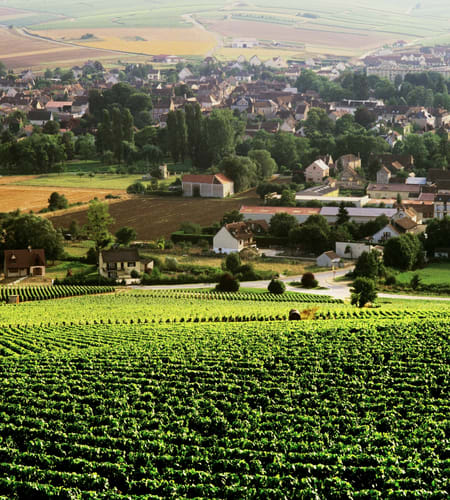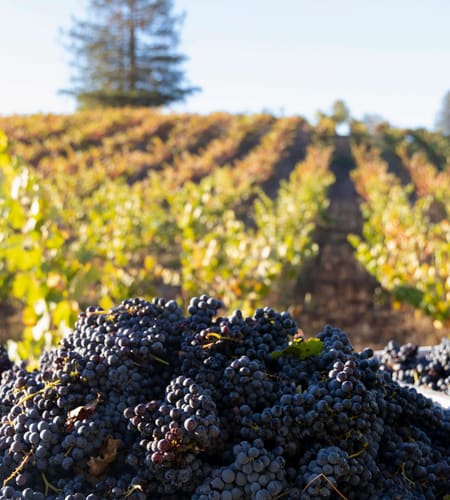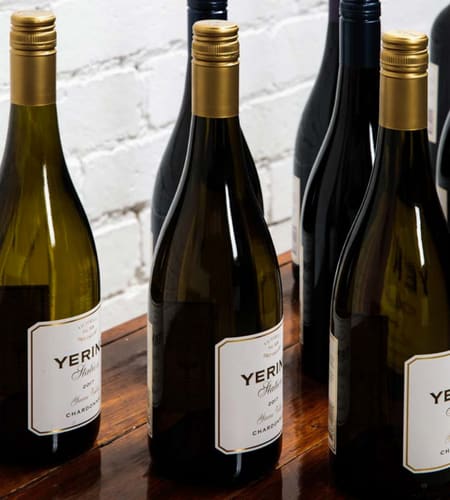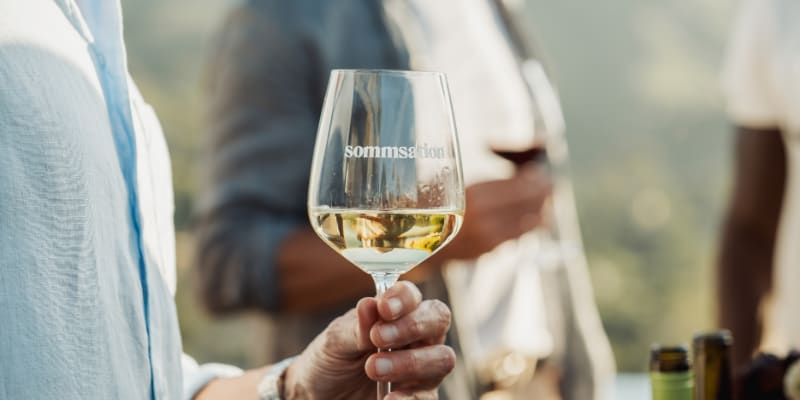Wine
Chablis vs Chardonnay, Explained
July 8, 2025

Chablis and Chardonnay—loved by wine enthusiasts, yet nuanced in their own right. While both popular amongst white wine aficionados, the terms Chablis and Chardonnay represent distinct aspects of the wine world, each with its unique characteristics. “The key difference between Chablis and Chardonnay is that Chablis is a type (and style) of Chardonnay,” explains Elyse Lovenworth, Sommelier.
“All Chablis wines are Chardonnay, though not all Chardonnays are Chablis.”To truly appreciate the nuances between Chablis and Chardonnay, one must delve into the intricacies of grape varieties, terroir, and winemaking techniques. By understanding these key factors, wine lovers can make informed decisions when selecting the perfect bottle for any occasion. Get to know the differences between Chablis and other Chardonnays through our in-depth comparison here.
Understanding Chablis and Chardonnay

Chardonnay: A Versatile Grape Variety
Chardonnay is a white grape variety that has captured the hearts of wine lovers worldwide. Its adaptability to various climates and winemaking styles has made it one of the most widely planted grape varieties, found in numerous wine regions across the globe. The flavor profile of Chardonnay is highly influenced by the terroir and the winemaker's approach; in cooler climates, Chardonnay tends to showcase crisp, citrusy notes with a distinct minerality, while warmer regions tend to produce richer, fuller-bodied expressions with more tropical flavors.

Chablis: A Region Dedicated to Chardonnay
Situated at the northernmost part of Burgundy, Chablis is a wine region renowned for producing exceptional Chardonnay wines. Wines from Chablis are renowned for their steely, mineral-driven character, which is attributed to the region's unique terroir. The cool climate and limestone-rich soils of Chablis impart a distinctive flavor profile to the wines, characterized by high acidity, subtle fruit notes, and a refreshing minerality.
“The name ‘Chablis’ is legally protected, meaning only Chardonnays from this particular region can use the name,” explains Lovenworth, affirming that Chablis is both a style and regionally specific expression of Chardonnay, renowned for its purity and minerality.
- Sommsation Experts Recommend:
Yering Station Estate Chardonnay 2021 ($34.00) - Built around a tight line of crunchy acidity, there is lovely texture and weight from barrel fermentation, which brings balance. There is wonderful length and a taut finish that, over the next five years, will relax further and offer even more.
Tamber Bey Vineyards Sans Chene Chardonnay 2023 ($45.00) - Boisterous aromas of orange blossom, litchee, white peach and candied pear announce its playful personality, while the palate displays a hint of oiliness and richness.
Key Differences

Terroir and Climate: The Influence on Taste
The terroir—a combination of soil, climate, and topography—plays a crucial role in shaping the taste of Chablis and Chardonnay wines. Chablis benefits from a cool climate, which allows the grapes to retain their natural acidity and develop complex mineral flavors. The limestone-rich soils of the region further contribute to the wines' distinctive flinty taste.
“As we know, Chardonnay is a grape variety grown and made in various regions around the world and the style of the Chardonnay varies as well depending on the region in which it is grown and the winemaker who makes it,” says Lovenworth. In contrast, Chardonnay grown in warmer regions, such as California or Australia, tends to produce wines with riper fruit flavors and a more lush, full-bodied texture. The warmer temperatures allow the grapes to develop more tropical and stone fruit notes, resulting in a different expression of the variety.
In terms of comparing Chablis with domestic expressions, Lovenworth cites wines from Oregon’s Willamette Valley as particularly interesting, as both regions emphasize terroir, but express it in distinctive ways due to differences in climate, soil, and winemaking philosophy. “While Chablis is considered full on cool, continental climate, Oregon’s Willamette Valley is more of a cool-ish, maritime climate,” she says, equally citing that the Willamette Valley has a longer growing season which helps the grapes ripen more fully and evenly. “This results in a riper fruit expression, though still with bright acidity,” she says.
Sommsation Experts Recommend:
Anderson Family Vineyard Chardonnay 2021 ($48.00) - Ripe honey-drizzled peach shows a real depth of fruit from the steep Dundee Hills estate of this small family-owned winery. Savory edges of cardamom and stony minerality frame honey peach and spiced pear.
Nysa Vineyards Chardonnay 2022 ($60.00) - Aromas of golden delicious apples and toffee mingle with a slight hint of chamomile and dried herbs. On the palate, this rich wine exudes the flavors of ripe pear and minerals, with a nice acidity to balance it all out. The lengthy finish is reminiscent of spiced nuts and a touch of caramel. Sauvignon is sometimes the opposite.”
Winemaking Practices: Oak vs. Unoaked

Winemaking techniques also contribute to the differences between Chablis and Chardonnay. Traditionally, Chablis sees minimal oak influence, with winemakers focusing on preserving the purity and expression of the terroir. This approach results in wines with a lighter body and a crisp, mineral-driven taste. On the other hand, Chardonnay wines from other regions often undergo oak aging, which imparts additional flavors and textures to the wine. Oaked Chardonnays, particularly those from California, are known for their buttery, vanilla-laced notes and a creamier mouthfeel, thanks to malolactic fermentation and barrel aging.
“Traditionally, Chablis winemaking focuses on emphasizing purity, minerality and freshness,” says Lovenworth, citing that local Chablis-basd winemakers will often use techniques that highlight the unique character that the cool climate and limestone soils impart on the Chardonnay from this region.
“Chablis is commonly unoaked or lightly oak influenced by barrel fermentation,” she says, stating that most Petit Chablis and Chablis AOC (entry level) wines are fermented and aged exclusively in stainless steel or concrete, to preserve the brightness and ease, whereas premier and grand cru Chablis may see neutral oak barrels for added texture.
Malolactic Fermentation & Bâtonnage (Lees Stirring)
Beyond oak regimen, Lovenworth cites the choice to implement—or block—malolactic fermentation (MLF) as another key technique in determining how a Chardonnay will present itself on the palate. “In Chablis, there is usually minimal malolactic fermentation, as avoiding or limiting it helps preserve the natural acidity,” she says, describing the process as one that converts
Additionally, winemakers can consider implementing sur-lie aging, which is a process that allows the wine to remain in contact with the dead yeast cells after fermentation. Lovenworth notes that in addition to aging sur-lie, one can also stir the lees up into the wine through a process called bâtonnage, which can add texture and complexity to a wine. While some premier and grand cru Chablis wines may be aged sur-lie, Lovenworth notes that avoiding overworking the wine with lees stirring is essential, as too much toastiness can cause the wine to veer away from the fresh, acid-driven profile associated with wines from the region.
Sommsation Experts Recommend:
Grape Culture Sangiacomo Chardonnay 2022 ($65.00) - Classic Sonoma Coast Chardonnay. Vibrant pineapple, guava, and lemon curd mingle with creamy layers, bright acidity, and just a touch of minerality.
Suisin Creek Winery Chardonnay 2022 (28.00) - Barrel aging for 12 months gives this wine its vanilla and graham notes with a light butterscotch aroma. The finish is refreshing, with a creamy texture.
Flâneur Wines Constantin Chardonnay 2021 ($50.00) - Aroma and flavors mirror one another and sing of yellow apple, Meyer lemon, a golden kiss of candle wax, honey, and graham cracker with a touch of French and Austrian oak for richness.

Taste and Texture: A Spectrum of Flavors
The taste and texture of Chablis and Chardonnay wines can vary significantly, offering a spectrum of flavors to suit different palates and food pairings. Chablis is celebrated for its:
High Acidity: The cool climate of Chablis preserves the grapes' natural acidity, resulting in wines with a refreshing, crisp texture.
Mineral-Driven Taste: The limestone-rich soils impart a distinct flinty or stony minerality to Chablis wines, adding complexity and depth.
Subtle Fruit Notes: Chablis wines often showcase delicate green apple, citrus, or white flower aromas, allowing the mineral character to take center stage.

On the other hand, Chardonnay from other areas offers a broader range of flavors and textures:
Diverse Flavor Profile: Chardonnay can exhibit a wide array of fruit flavors, ranging from crisp green apples and citrus in cooler climates to ripe tropical fruits and stone fruits in warmer regions.
Oak Influence: Oaked Chardonnays, like those from California, often display rich, buttery notes and hints of vanilla, caramel, or toasted nuts from barrel aging.
Varied Body and Texture: Chardonnay wines can range from lean and crisp to full-bodied and creamy, depending on the climate, winemaking techniques, and oak influence.
This diverse range of flavors and textures makes Chardonnay a versatile wine, suitable for pairing with a wide variety of foods, from delicate seafood dishes to rich, creamy sauces. Chablis, with its high acidity and mineral-driven taste, is often the preferred choice for pairing with oysters, shellfish, and light, citrus-based dishes.
Whether you prefer the crisp, mineral-driven elegance of Chablis or the diverse flavor profiles of Chardonnay, both wines offer a captivating journey for your palate. Embrace the opportunity to explore these iconic white wines and discover the nuances that make each one unique through a personalized wine tasting experience, or browse our curated wine selections to taste the flavor profile spectrum firsthand.


